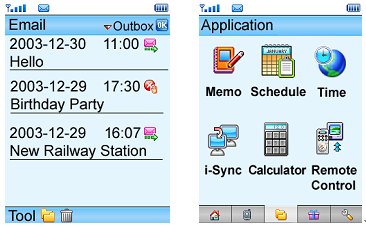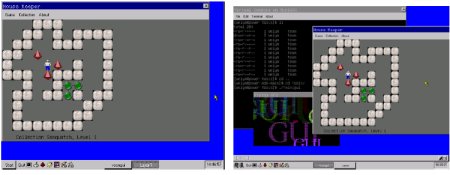MiniGUI moves upmarket with multiple process Linux support
Oct 25, 2005 — by LinuxDevices Staff — from the LinuxDevices Archive — 14 views An independent software house in China has updated its dual-licensed, lightweight graphics framework and window manager. Beijing Feynman Software's 2.0.1 release of MiniGUI-VAR adds support for multiple processes, and targets high-end embedded systems running embedded Linux. Older releases support uClinux, eCos, and various commercial OSes.
An independent software house in China has updated its dual-licensed, lightweight graphics framework and window manager. Beijing Feynman Software's 2.0.1 release of MiniGUI-VAR adds support for multiple processes, and targets high-end embedded systems running embedded Linux. Older releases support uClinux, eCos, and various commercial OSes.
Background
MiniGUI was originally written six years ago by Yongming Wei, for use in CNC (computer numerical control) manufacturing equipment. It was later ported to uClinux and eCos, and released under the GPL, subsequently attracting a worldwide community of developers.
Wei and other principal MiniGUI developers founded Beijing Feynman Software about three years ago, and began offering MiniGUI-VAR (value-added release), a supported version that adds a number of enhancements over the free version, as well as support for a variety of commercial embedded OSes, including VxWorks, Nucleus, ThreadX, pSOS, and Win32. Feynman continues to maintain free, GPL versions of MiniGUI.
Additionally, a number of free software applications have been ported to MiniGUI, including browsers based on Dillo and Konqueror, a media player based on Xine, a map renderer, and a free Flash player.
About MiniGUI
Feynman says MiniGUI compares favorably to other embedded graphics frameworks, such as Qtopia and MicroWindows, especially in terms of resource requirements and real-time performance. Its library has a footprint between 500KB and 700KB, while its fonts, bitmaps, and other resources occupy between 400KB and 2MB. Thus, the company says, it can be used to build fully graphical Linux systems supporting multiple application window layers, with total Flash footprints between 2MB and 4MB. It can run on a 30MHz processor with 4MB of RAM, Feynman claims.
Feynman says MiniGUI has been used by large companies in China and around the world, in mobile phones, set-top boxes (screenshot), and in industrial control and instrumentation devices (screenshot). Its website implies that China's government-owned telco, Datang — which largely created the TD-CDMA standard — uses MiniGUI in some mobile phone designs, although Trolltech has also claimed that Datang uses Qtopia in its Linux mobile phone designs.

These screenshots show MiniGUI running on an eCos-based mobile phone
About MiniGUI-VAR
The latest release of MiniGUI, version 2.0.1, is developed for Linux and VxWorks 6, although only the Linux version is currently shipping. It is based on MiniGUI-VAR V1.6.8, with added support for multiple processes, to support high-end embedded applications.

The left screenshot shows MiniGUI 1.6.8 running in single-process mode. Multiple running applications each have their own layer, and only one layer at a time is displayed. The shot on the right shows MiniGUI 2.0.1 running in multiple process mode
(Click to enlarge)
Compared to the GPL versions of MiniGUI, MiniGUI-VAR V1.6.8 adds the following, Feynman says:
- Component enhancements and optimizations based on customer feedback
- Zero-copy bitmap loading
- Expanded image format support
- Dynamic system color management
- In-core resource management
- Palette management
- Timer management
- Etc.
- Graphics APIs for low- and high-end video devices
- Raster operations
- Complex regions
- Draw or fill ellipse, arc, and polygon
- Advanced 2D graphics using C99-compliant math library
- Practical controls
- Animation control
- IconView control
- GridView control
- Enhanced support for charsets and fonts
- Complete Unicode support
- In-core QPF font support
- Anti-aliasing
- Dynamic zooming
- Support for low-level video devices and special video devices, based on NEWGAL (new graphics abstraction layer)
- Common embedded functions
- Touchscreen calibration
- Three hundred bugfixes
Feynman additionally offers a simplified version of MiniGUI V1.6.2 called MiniGUI-STR V1.6.2. It is suitable for students learning about uClinux and graphics frameworks, the company says.
Availability
MiniGUI-VAR V2.0.x is available now for Linux. It supports multiple process modes, threaded mode, and standalone (single-process) modes.
MiniGUI-VAR V1.6.x is available now with all modes supported under Linux, and most supported under uClinux. Threaded mode support only is also available for VxWorks, pSOS, eCos, uC/OS-II, ThreadX, and Nucleus.
An “all-in-one” product supporting all embedded OSes is also available.
Feynman offers subscription-based licenses, targeting products with annual sales under 5,000. It also offers run-time royalty based licensing, starting at quantities of 100, with volume discounts.
This article was originally published on LinuxDevices.com and has been donated to the open source community by QuinStreet Inc. Please visit LinuxToday.com for up-to-date news and articles about Linux and open source.